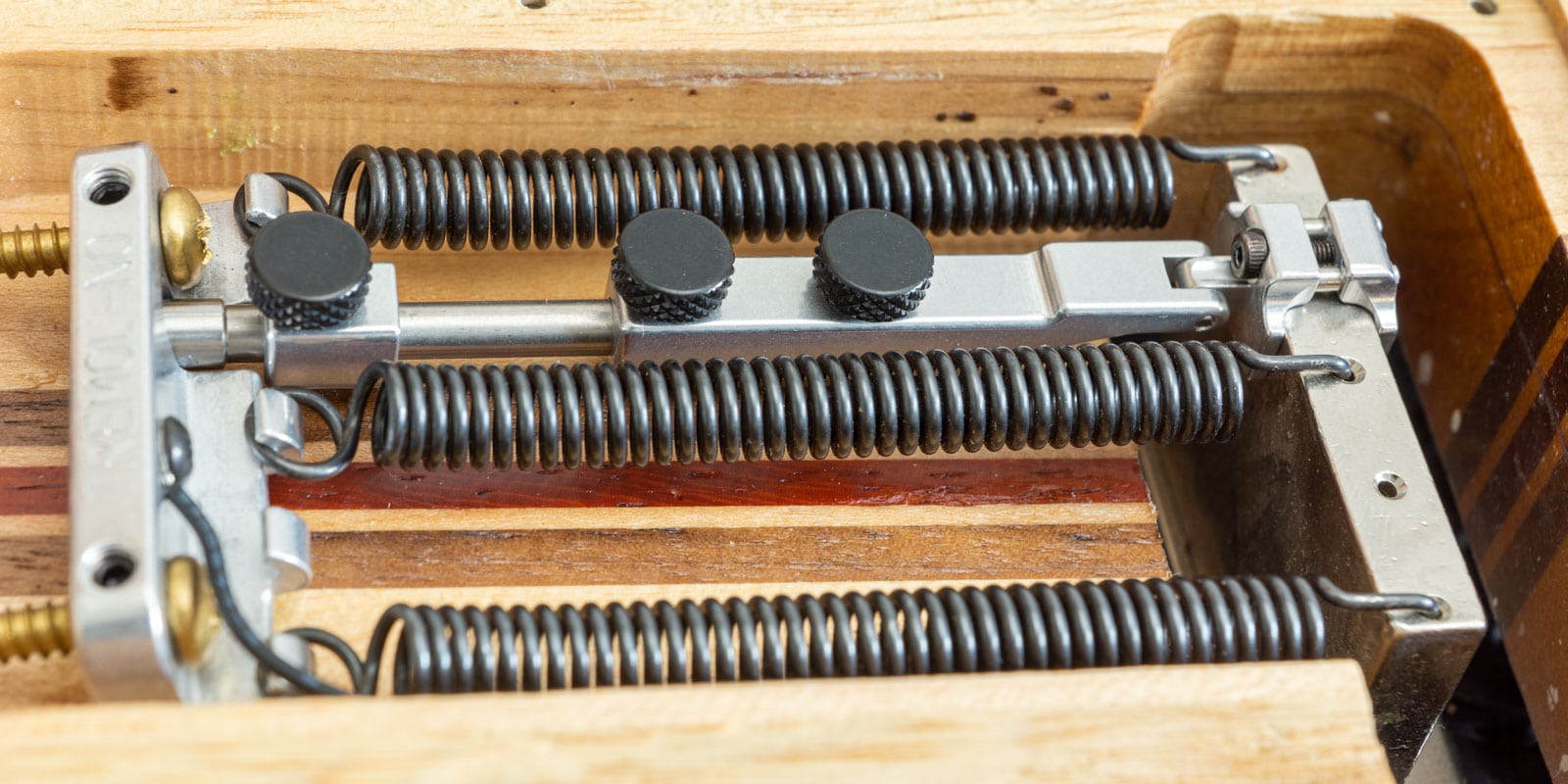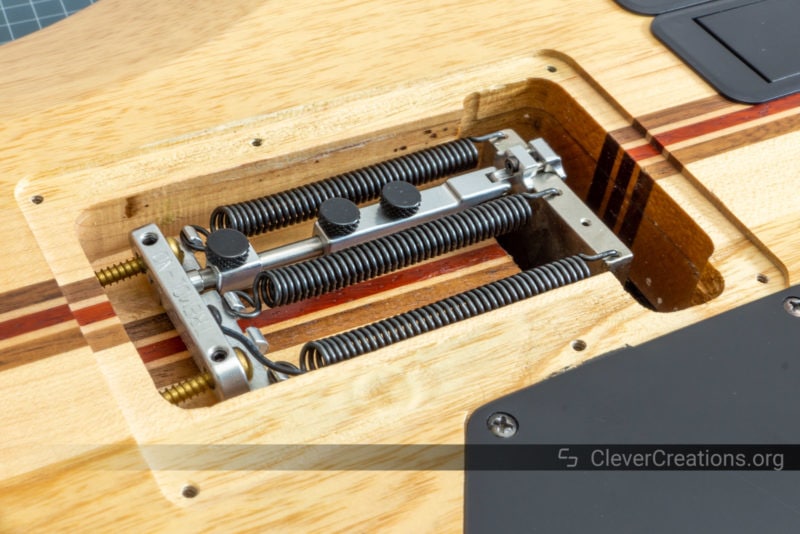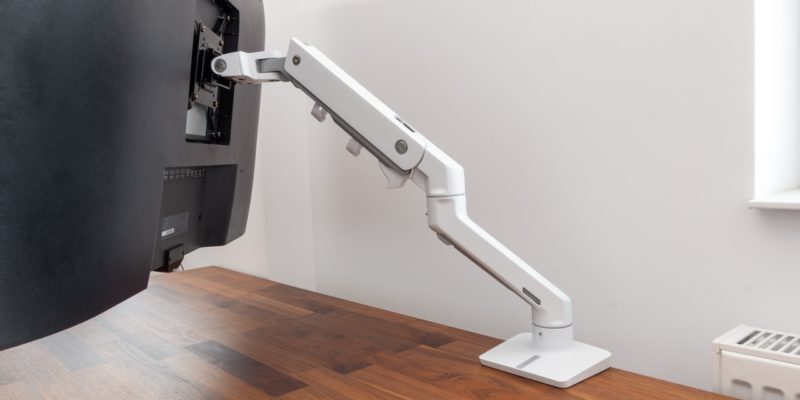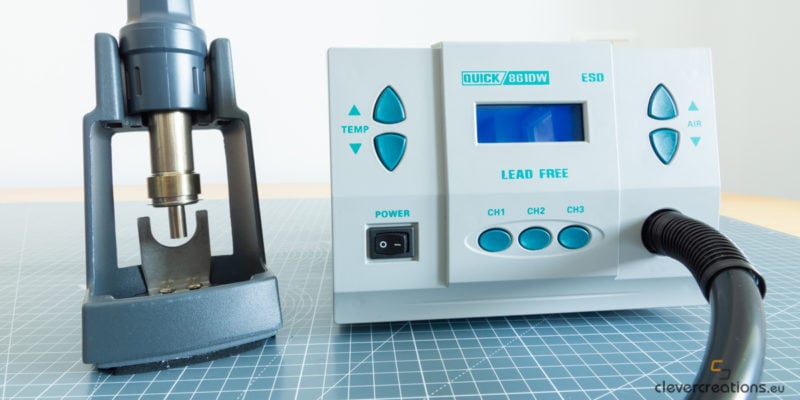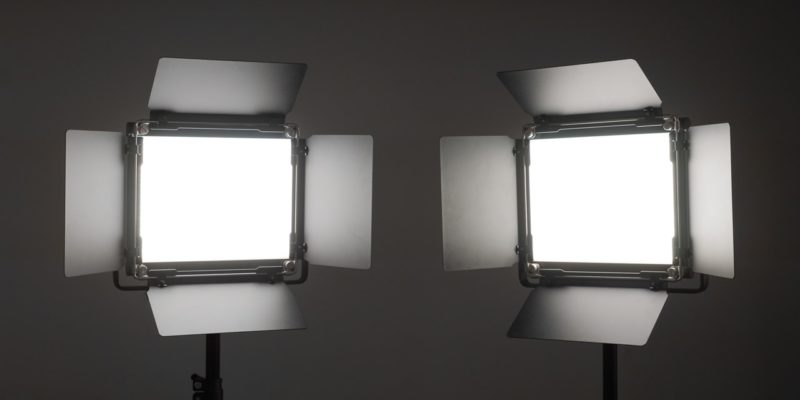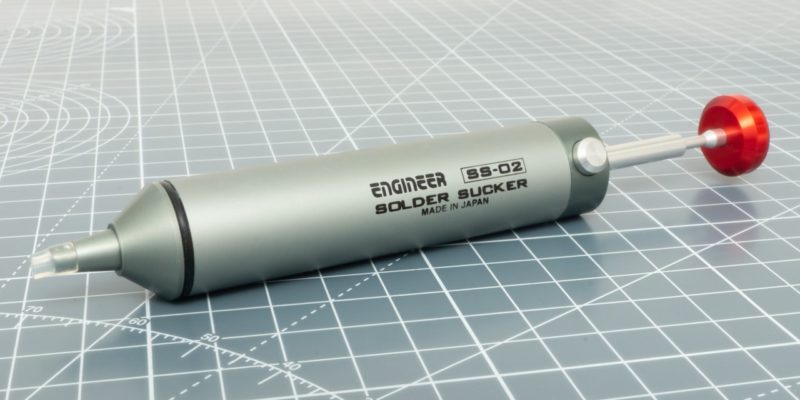- No permanent modifications to guitar required
- Increased sustain
- Allows for easy switching between tunings
- Makes Floyd Rose-equipped guitar setup easy
- Increased tuning stability
- Tricky to install correctly
- Disappointing installation instructions
- Back panel won't fit anymore on some guitars
Guitarists that have used tremolo bridges know that they can be a nuisance at times. While they can add an extra dimension to your playing, they also cause problems with tuning stability, complicate guitar set up and make it impossible to quickly change tunings.
Locking devices like the Tremol-No attempt to solve these problems. By giving you the option to secure the bridge in place, you get the choice of switching between a floating or hardtail bridge whenever you want. In theory, this makes the guitar considerably easier to work with.
Whether this is actually the case is something I will test in this review of the Tremol-No. When you are done reading, you will know the effects of installing the device in your guitar, know about alternative methods you can use to fix your guitar bridge in place, and whether the Tremol-No is worth your money.
Let’s dive in!
What is a Tremol-No?
The Tremol-No is a device that lets you lock a Floyd Rose or similar tremolo system in place. With the twist of a couple of thumbscrews, you can switch your guitar’s bridge from floating to hardtail or the other way around.
It works with most tremolo systems and can be installed without making permanent modifications to the guitar.
Why Use a Tremol-No?
While a tremolo system on a guitar can be a lot of fun, it does come with several downsides that make some people avoid them altogether. Issues with tuning stability and difficulties switching between tunings are probably the most notable drawbacks.
Locking systems like the Tremol-No let you enjoy the whammy bar when you want, but also give you the option to fix the bridge in place and avoid the issues that come with a floating bridge altogether.
Compared to a floating-only bridge, the Tremol-No claims to give the following benefits:
- Quickly change tunings. Switching to a different tuning is a hassle with a Floyd Rose-equipped guitar and is practically impossible to do quickly. Each time you adjust the tension on one string, all other strings change their pitch. Locking the bridge down, on the other hand, lets you quickly tune to different tunings like drop D, without having to rebalance the entire system.
- Easier guitar setup. Anyone with a Floyd Rose or other type of tremolo knows how much of a headache guitar setup can be with a floating bridge. Switching strings and tuning them or adjusting the guitar’s intonation can take up a lot of your time. Locking the bridge during this process, however, makes it as easy as it is on a hardtail guitar. Set the bridge to floating once the guitar is in tune and you can start playing right away.
- Added sustain. While this effect tends to be relatively minor, the added mass of the locking system components does increase the sustain of a guitar. The effect is most noticeable when the bridge is locked.
- Easier unison bends. Unison bends are tricky with a tremolo, because as one string is bent up, the other drops in pitch. You can compensate for this by slightly bending the unbent string or by applying counterpressure on the floating bridge, but having the bridge locked in place obviously works better.
- Strings don’t go out of tune when resting your palm on the bridge.
- No change in tuning when a string breaks.
- Better tuning stability.
This all sounds great in theory, but let’s see whether the Tremol-No actually delivers on these claims.
Unboxing
The box of the Tremol-No contains the following:
- Pre-assembled Tremol-No system
- Hex keys for installation
- 1x spare thumbscrew
- 1x spare O-ring
- 3x set screw
- 4x aluminum spacer
- Instructions
For this review, I use the small clamp version of the Tremol-No. The two other models, the large clamp and pin type, are practically identical, but differ in the way they attach to the tremolo block. More on the different models later.
| Allparts Tremol-No Specs | |
|---|---|
| Dimensions (uninstalled) | Overall length: 81 mm Width: 51 mm Height: 13 mm |
| Dimensions (installed) | Overall length: 94 mm Width: 51 mm Height: 13 mm |
| Weight | 35 g / 1.229 oz. |
| Materials | Shaft: 304 Stainless Steel Dowel Pins: 316 Stainless Steel Set Screws: Alloy Steel (zinc plated) Thumbscrews: Alloy 360 Brass (anodized) Tailpiece: 7075 T-6 Aircraft Aluminum All Other Parts: 7075 T-6 Aircraft Aluminum |
Installation
Let’s start with my biggest gripe with the Tremol-No: its installation instructions. Unless you already know exactly what to do, it is likely that you will end up with a suboptimal setup when you choose to install the device yourself. This is because the included instructions as well as the official instructions online are seriously lacking in clarity.
For the Tremol-No to work properly, it needs to be installed so that it creates minimal friction. Understanding how to adjust its components to achieve this is key in getting a good result. There are plenty of reviews from people who were (understandably) not able to figure out how to install it correctly and ended up giving up on the device.
To help you with this, I have created a more detailed post on how you can install a tremol-no system yourself at home. Of course, you can also choose to have a skilled guitar tech/luthier take care of it for you.
I do recommend you to give it a shot yourself first, as installing it yourself teaches you how the Tremol-No works, how to troubleshoot it and saves you some money. The entire process takes about 30 minutes (with the right instructions) and there is no risk of permanently damaging your guitar in any way.
Locking Ability
The main requirement of a tremolo locking device is that it reliably locks a floating bridge in place without any unwanted movement. In that aspect, the Tremol-No does exactly what is asked from it.
With the thumbscrews of the device locked down, the bridge remains in a fixed position while you play. You can safely rest your palm on the bridge or apply a reasonable amount of force with the whammy bar, the bridge won’t budge. This ensures that the strings stay in tune, which is exactly what we want from a device like this.
If you do experience unwanted movement with the Tremol-No, it is likely caused by the setup of the Tremol-No or by an issue with the guitar itself. I have covered these issues and their respective fixes in the aforementioned installation article.
Ease of Use
Using the Tremol-No is fairly straightforward. Switching the bridge from hardtail to floating (or vice versa) is easy and takes mere seconds. Anyone can do it.
The only usability issue I have encountered is that the thumbscrews do not provide much grip. As a result, if you have sweaty hands or limited finger strength, they can be hard to adjust with just your fingers. For that reason, I usually replace the thumbscrews with the included set screws that are operated with a hex key.
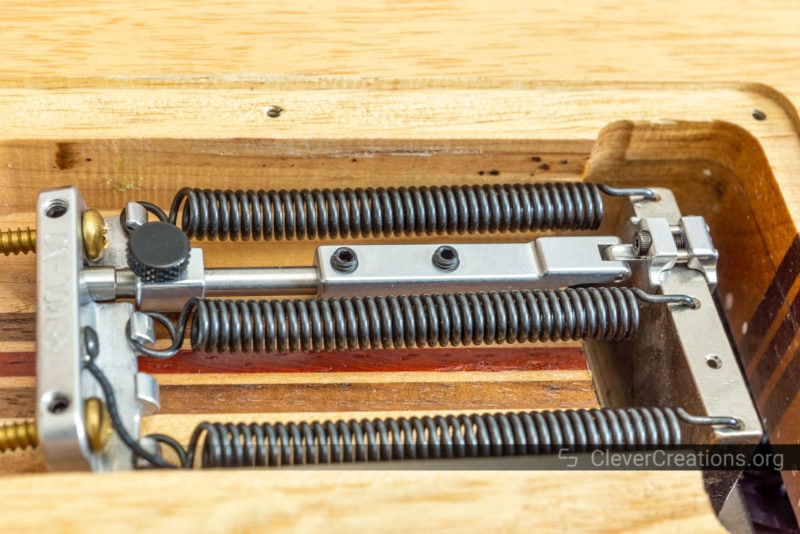
The Deep-C clamp (pictured on the left with the thumbscrew in it) is equally easy to use. Position it up the sliding arm to allow dive-only movement of the tremolo, or move it out of the way (as pictured) if you want the tremolo to have its full range of motion.
Compatibility
I have installed Tremol-Nos in various guitars and have not run into any compatibility issues so far. All popular tremolo systems are supported, even though you do need to make sure that the Tremol-No model you use is compatible with the tremolo system. More on that later.
Something else to keep in mind is that depending on the amount of space in the tremolo compartment of the guitar, you might not be able to fit the back panel on anymore with the Tremol-No installed.
However, you might want to leave the panel off anyway so that you have access to the Tremol-No’s locking screws. Alternatively, some people cut a hole in the panel for easy access.
Build Quality
The build quality of the Tremol-No is okay. There are things that it does well, but also things that can be improved upon.
To start with the positives, the device is made from the right materials, has a quality finish and is constructed with narrow tolerances. Especially the tolerances are important, as you don’t want any play in the components that causes the bridge to wobble.
What can be done better is the screws that lock and unlock the Tremol-No. Because they are exposed to vibrations when you play guitar, they have a tendency to vibrate loose and fall out. This occurs mostly when the screws are loose already (when the bridge is floating) and happens regardless of whether you use the thumbscrews or set screws for locking.
While the Tremol-No kit does include spare screws, it would have been better if the screws came with pre-applied Loctite from the factory. This would absorb the vibrations and prevent the screws from coming loose.
You can just apply Loctite during installation or later on, so in my opinion this issue is not that big of a deal.
Advantages
Provided that the Tremol-No is installed correctly, it does provide the benefits you would expect from it. Switching it to hardtail mode lets you set up your guitar, change intonation or switch tunings with ease. On top of that, tuning stability is better, unison bends are easier to execute and your guitar will not go out of tune anymore when you rest your palm on the trem bridge.
Sustain is improved as well, even when the bridge is set to floating mode. The increase in sustain is comparable with upgrading to a thick brass sustain block. You can combine these methods to get even more sustain.
Unlike its manufacturer claims, I have not noticed an improvement in tone after installing a Tremol-No. Then again, I rarely play with a clean tone, so it is possible that I simply did not pick up on it.
Downsides
All in all, the Tremol-No has relatively few shortcomings. The ones it does have are fairly easy to solve.
Its limited instructions can be compensated for by finding better instructions online. The hard to adjust thumbscrews can be replaced with the easier to use set screws. If any of them come loose over time, simply apply Loctite 242 to them.
On some guitars you won’t be able to fit the back cover on the tremolo cavity anymore, but you will need access to that area anyway if you want to lock and unlock the bridge. Alternatively, you can also cut an access hole in the back panel itself, but that does require you to permanently modify your guitar.
Another thing to keep in mind if you want to use the Tremol-No (or any other tremolo locking system) is its effect on trem flutter. Because the extra friction of the Tremol-No system affects the movement of the tremolo springs, it is possible that you won’t be able to use this technique anymore. In the end, this depends on several factors, like the Tremol-No setup, the strength of the springs and friction from the bridge’s knife edges.
How Does the Tremol-No Compare to the Tremsetter?
A comparison between the Tremol-No and Hipshot Tremsetter is sometimes made, but despite both interacting with the tremolo system, they are different devices with different purposes.
The Tremol-No lets you lock your tremolo altogether, whereas the Tremsetter is designed to return your trem to the exact same point each time you release the whammy bar.
The Tremsetter is bulkier than the Tremol-No, and it is unlikely that a random tremolo cavity has enough space to combine them. Not that you would want that anyway. A properly set up tremolo system with a Tremol-No should also reliably return to the same zero point.
Tremol-No vs a Tremolo Stopper
A tremolo stopper, stop or stop lock is a rudimentary device that prevents a tremolo from being pulled up, only allowing dive-only movement. A Tremol-No provides the same functionality, but also gives you the option to fully lock the bridge.
In addition, a trem stop requires you to drill into your guitar, whereas the Tremol-No does not require any permanent modifications.
Advantages of a tremolo stopper are that it is cheaper and easier to set up than a Tremol-No.
Tremol-No vs a Wood Block
Aside from using a Tremol-No to block the tremolo, another popular method is to insert a wooden block in between the tremolo block and guitar body. It works well and has a low cost associated with it.
A wooden block is an excellent solution if you want to permanently block the trem, but is not ideal if you plan on switching the bridge between hardtail and floating modes. For that, you are better off with the flexibility that a Tremol-No gives.
To get the wooden block to fit snugly in the cavity, you might also have to spend a decent amount of time (hours) whittling it down to the perfect size. A straightforward rectangular block is unlikely to fit well.
Both a Tremol-No and a wooden block increase sustain, but opinions differ on which solution increases sustain more.
Which Tremol-No Model Does Your Guitar Need?
When buying a Tremol-No, there are three different models you can choose from: the small clamp, large clamp and pin type. Different guitars have differently shaped tremolo/sustain blocks and these models attach to all common shapes and sizes.

If your guitar uses a rectangular tremolo block up to 8 mm in thickness, it is best to use the small clamp model.
The large clamp works for thicker rectangular blocks up to 13 mm thick. You are likely to need this model if you ever upgraded your sustain block with a fat brass one (a great upgrade for both tone and sustain!).
For rounded tremolo blocks there is the pin type Tremol-No. As the name suggests, this model uses a pin to attach to the block instead of a clamp.
On this page you can find more information about compatibility with various tremolo systems.
Conclusion
The Tremol-No is far from perfect, but when installed correctly it lives up to its claims. Despite its shortcomings, it is the best option to block and unblock Floyd Rose-type tremolos.
With a Tremol-No on your guitar, you can expect better sustain, easier guitar setup, the ability to switch between tunings without hassle, better tuning stability and more. Switching the bridge between floating, dive-only and hardtail modes takes mere seconds.
To avoid common pitfalls, however, it is essential to set the device up correctly and apply Loctite 242 to the threads of the thumbscrews or set screws (depending on which screw type you choose to use).
Unlike some other tremolo locking methods, the Tremol-No lets you revert your guitar back to its original state whenever you want. There is no need for drilling or other permanent modifications.
Comparing the cost of the device to its benefits and time-savings, I would say that installing a Tremol-No is a no-brainer for any Floyd Rose-equipped guitar.
